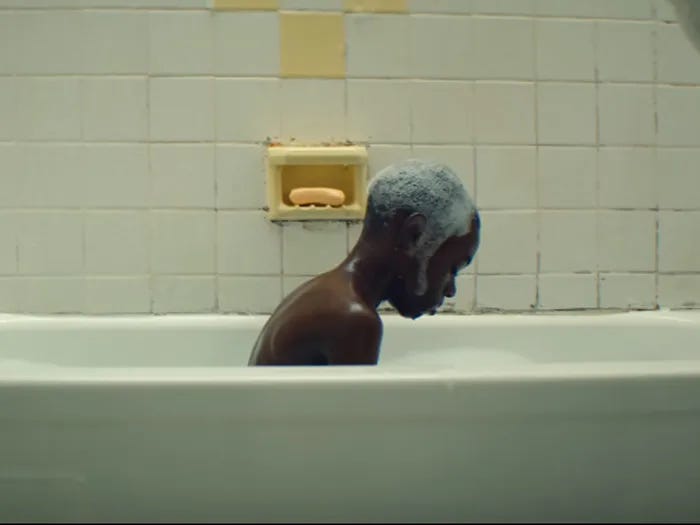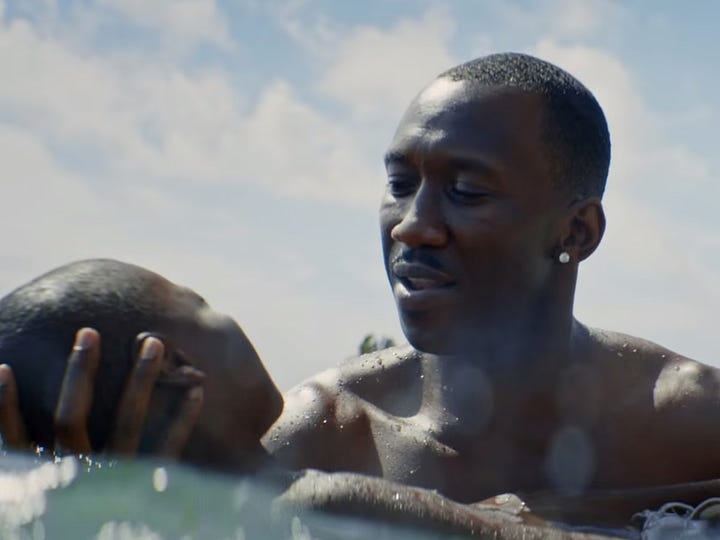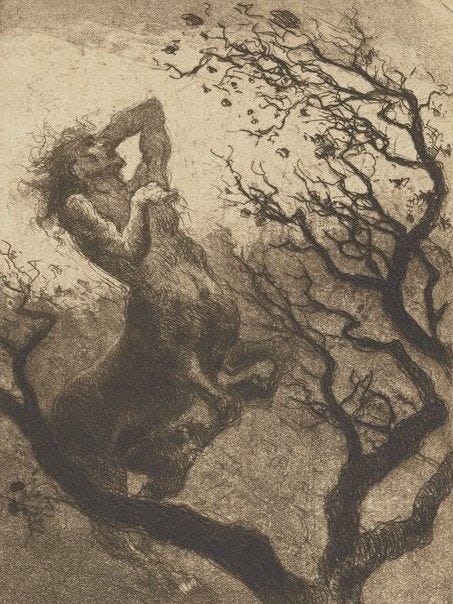[Note: I’m on IG again, kinda? 🙃]
"Who is you, Chiron?"
“Man, I cry so much sometimes I feel like I'm just gonna turn into drops.”
“Just roll out into the water, right? Roll out into the water just like all these other muthafuckers around here trying to drown their sorrow.”




I knew Moonlight was one of those films with crushing impact the first time I saw it, yet I was doubtful I’d ever watch it again (along with Manchester By The Sea, my gosh).
But I rewatched it earlier this year and a new meaning emerged, one I didn’t catch on the first viewing eight(?!) years ago when I saw the main character’s name pop up on the closed captions: Chiron.
Pronounced in the film as Shy-rone, it’s the same spelling as the revered “wounded healer” in astrology — Chiron, pronounced Ky-ron.
One of my astrology teachers Cristina Farella who I studied with both in the School of Divine Sympathies and a Chiron-dedicated 4-week workshop eloquently writes,
Chiron, in myth, is a centaur famed for his ability to heal any wound, save for his own. Injured by a poison-tipped arrow, one of Heracles’s arrows soaked in the poisonous blood of the Hydra, Chiron suffers for much of his life, all the while offering his medicinal expertise to those in need.
His story ends in self-sacrifice, after a lifetime’s worth of suffering; he offers to take Prometheus’s place in the underworld, freeing an important liberatory figure as his last act of generosity and renewal.
Astrological Chiron holds this kaleidoscopic approach to healing, to wounding, and the tension between those two extremes. Your Chiron placement, broken down by sign, house, and aspect, offers a multifaceted story of your own innate wounding— and the cure that lies therein.
For the last year, I’ve been working with the astrological oracle deck by Lily Ashwell. A way to both study astrology and use it as a “divination” tool (which, for the record, is not about fortunetelling but rather classic Jungian/archetypal depth psychology), it’s been a beautiful exploration of themes, synchronicities, and symbolism.
In 2023, Chiron was my most pulled card.
As said above, our Chiron placement is a wound that never really leaves us.
In the film, our wounded antihero and title character Chiron kept having the same experiences mirrored from his early life and upbringing into his adulthood experiences and relationships. This is the Chiron effect, one that we all know all too well.
Cristina also states that the Greek word pharmakon means both “poison” and “cure.” It prompts a seeming paradox, but what it’s really representing is an innate tension, an alchemization, and the mysticality of the tools of the healer.
Chiron is a pharmakon, the Greek word that means “poison” and “medicine” simultaneously. He’s a paradox, a puzzle. He contains information about what most deeply wounds us, while also offering us the key to healing, so long as we fully engage with the wound in question. — Cristina Farella, Eighth House Astrology
To get to know our Chiron placement is not to “transcend” it, therapy it away, or become devoured by it, but to let it pierce us, poison us, and then use that pain as medicine.
When I learned my own Chiron is in Leo in the 10th house (the house of purpose, legacy, “career”, etc.) what first/flash came to mind was that my wounding must be my latent self-absorbedness, my thinking no one really “sees” me, and that no wonder I’ve never been able to thrive in any solid “career” as defined by the West. (Ouch!).
For the record, there isn’t a definitive moment in time that put a wounded stake in the ground. It just felt like a bit of an a-ha that a wounded Leo is a lion who, while in the wild, is majestic, royal, and exalted, can also be a sad circus creature that became caged, toothless, dangerous, a bit scary, and lashing out of fear.
This resonated with me and I began a deep dive into the aspects of my Chiron (aspects are the flavor of how the planets are talking to each other and thus expressing themselves in your chart and life) which are, unsurprisingly, making very strong placements to my Sun, Ascendent, and Midheaven, meaning my wounds show up right on my sleeve, unhidden, wily, and raw to the world.
I’m getting tired even for a phoenix. Always rising from the ashes, mending all her gashes.
The symbol of Chiron looks like a key (⚷). Perhaps an awareness of the wound is just the beginning — a turning of the lock.
To get to the “other side” of understanding, of integration, and of bearing the fruits of the womb there is a key needed to get through the door. The only one is yours. How you walk through the door and the rest of your life belongs to you and you alone.
In Moonlight, our title character Chiron can’t help but wear his wounds on the outside, but he also confronts them (his mother, his high school crush), thus bringing him closer to the truth of who he is — a multilayered being, a phoenix, a cosmic miracle, a gift.
I’m trying to temper my flair for the dramatic (Leo midheaven!) but I used to sometimes think about how I’m “poisoning” myself consistently (and with reverence) every time I take my liquid Lexapro. I’m still on a taper, which I wrote about here.
Something that’s helped is looking at this “poison” as something that’s teaching me — something that irrevocably changed my life and as I lower the dose over time, how can I work with what it’s bringing up in me? I could ignore it and numb out, or just give up altogether, but the cliche is true: the only way out is through.
As I experiment with the metaphorical “poisons,” I lean into it the feelings. I sit with it and see how far I can go into it without collapsing, pushing out, trying to fix, change, or seeking any comfort or restitution from outside sources. How long can I be with the sensations?
Earlier this year I worked with Kathryn Solie of Persephone’s Path (all of my teachers are Virgo women 🥲) diving into the meaning, spirit, communication, and consciousness of poisonous plants and what they are here to show us.
And I’m not talking about psychoactive plants like peyote, ayahuasca, and psilocybin, but actual poisonous plants (deliriants) like Belladonna, Datura, and Henbane that have been revered for centuries across every continent, worked with ritualistically/ceremonially and medicinally, and have long-held value in mythology and folklore. (Note: none of these plants should ever, under any circumstance, be ingested outright.)
In our sessions we journeyed with each plant (never ingesting), calling in the spirit of the plant during a drumming session. In the journey, we may see images/visions, feel bodily sensations, hear words or languages, etc.
With a beginner’s mind, I went into this with zero expectations. Something pretty remarkable is that each plant has a throughline in the journey for me regarding symbolism: pearls (as a carrier of wisdom), sex/pleasure, death, and pregnancy/birth.
I love having a beginner’s mind… going in I expected nothing and coming out I had several written-down journeys and messages from eight poisonous plants. It was such a neat experience and something I think we used to have far more access and intuition to in eras past.
The pearl was particularly significant to my journeys and is why I have a Moonpearl section on my substack. I listened to this podcast episode on “The Pearl” to better understand its symbolism.
Finding the pearl, the self, in that unconscious “feminine place” is a journey into the forest, the cave, the ocean floor, the underworld, the murky and dark — that’s where it’s hidden after all.
The pearl is very lunar. The moon controls the tides, the face of the full moon quite literally resembles a pearl. There are phases of the moon like there are formations of the pearl. The feminine water, moon pearls. “Finding” the pearl brings us more into the solar, the unification of inner and outer.
And most importantly, pearls are made through irritation — the pearl is the alchemy between the oyster and a single grain of sand.
Poisonous plants also seemed to have a connection, to me, with “villainous women.”
I’ve spoken on “the feminine” before and how the feminine, much like Gaia or Earth, is often portrayed in this gentle, demure (sigh) light that is only one-half of the face of the moon, isn’t it?
I’ve spoken about rage here and how as women it’s degenerate, wrong, and “off” for women to display and express rage, to display darkness (and two of my favorite novels have main characters that are exactly that). Dr. Clarissa Pinkola Estés of Women Who Run With the Wolves said women’s tears and anger were considered extremely dangerous as women are the keepers of all secrets… of everything buried in the crevices of the past.
Take one look at the natural disasters of this planet to understand there is no magical sunrise without the devastation of a brutal fire engulfing the west coast. There is no soft, delicate snow without the destruction of tsunamis and the likes of Katrina.
It lives in you, it lives in me.
With these poisonous plants, I couldn’t help but be utterly enamored by their beauty while holding the truth of how deadly they are.
I was walking home from work back in April and stumbled upon the most stunning large tree of hot, bubblegum pink flowers. Pink Oleander. Every single part of that plant could kill me, a grown adult. She smelled like candy.
Many of the fruits of these poisonous plants, such as Belladonna berries, grow close to the ground — a child’s height. What is the purpose, we ask?
Why is something with such reverent beauty so deeply poisonous? Why have these plants lured children for centuries, causing them to be given nicknames like Devil’s Trumpet, Beautiful Death, Witches Gloves, and Dead Man’s Bells?
Ahhh… Witches. When I was gardening this summer the main “weed” to be eradicated was one called Witches Grass. It’s not lost on me that Puritan New England named something they deemed a nuisance, a problem as such.
There is a good principle that created order, light, and man, and a bad principle that created chaos, darkness, and woman. | Pythagoras
Most of the poisonous plants we studied have also been used throughout history as medicine. Yew trees’ poisonous alkaloids are now known as chemo-therapy taxanes. Datura smoke was used by native tribes in California to relieve the pain of rheumatism and earaches. Foxglove contains digitalis that has been used to treat heart failure and high blood pressure. Like Chiron, poison is used as medicine.
Chiron and the moonpearls of the poisonous plants are messengers bringing us back to the very place you wanted to avoid: you.
Let them open you — let them whisper in your eyes what you asked to be revealed to you.
You have eyes but you do not see.
With Chiron and the wisdom of poison, we have no choice but to see. To bear witness to all that is — something luminous and valuable, glinting on the slimy, shadowy ocean floor — full of endless dark and glimmering light.1
∞
Seeing the world in a grain of sand,2
Tracy











Tracy return to us on substack!
Wow, this had everything. Chiron’s story of poison as medicine (I was introduced to him through Song of Achilles), the friction/irritation that alchemises pearls and working with witches plants and herbs. Thank you for your story telling